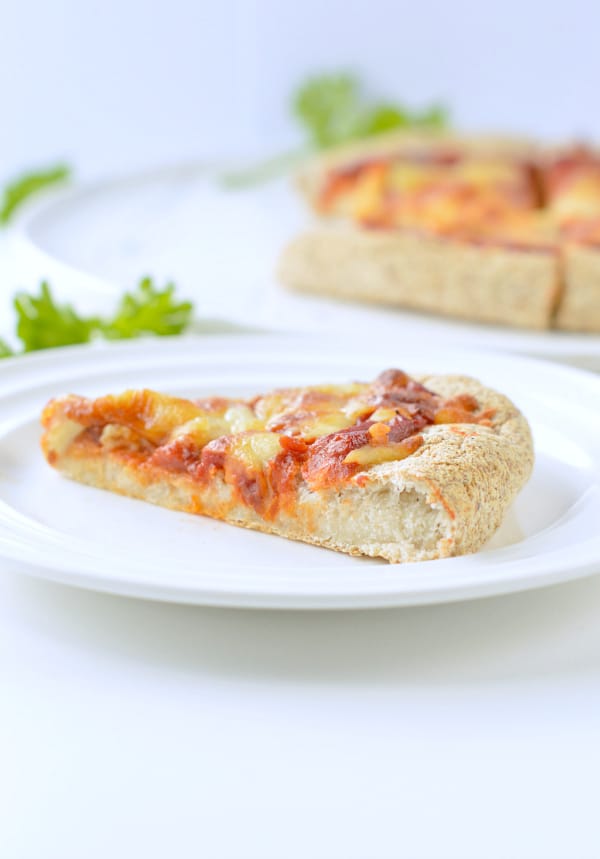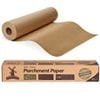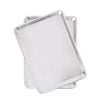Low-Carb Pizza Crust (Keto, Vegan)
This recipe may contain Amazon or other affiliate links. As an Amazon Associate I earn from qualifying purchases.
This Low-Carb Pizza Crust is the best keto pizza base made without eggs or cheese. A flavorsome bread flavor, crispy puffy edges, and only 2.7 grams of net carbs per serving.
Plus, this low-carb pizza base is also a gluten-free pizza crust with no yeast and is 100% plant-based.

What’s A Low-Carb Pizza Crust?
Low-Carb Pizza Crust is a keto-friendly base made with low-carb flour for a thick and puffy pizza and since it’s made without eggs, you won’t have any eggy taste!
I’ve already shared my egg-free keto bread loaf recipe, and this vegan keto pizza crust is another delicious low-carb baking creation that tastes like the real thing!
If you are tired of fathead pizza doughs, this vegan, low-carb pizza base will be your friend!
Why You’ll Love This Recipe
While most low-carb pizza bases call for eggs and cheese, this recipe is here to show you how you can actually make a delicious crispy Italian-style pizza without eggs and cheese but with a delicious bread flavor.
The secret of this egg-free low-carb pizza crust is its combo of simple ingredients and a magic rolling technique. It’s a thicker alternative to my Keto Pizza Crust.
- Gluten-Free
- Low-Carb
- Keto-Friendly
- Egg-Free
- Dairy-Free
- Vegan
- Puffy Crust
- 8 Basic Ingredients
- Ready In Under 30 Minutes.

How To Make Low-carb Pizza Crust
Making this keto pizza recipe is easy as pie. The base only takes 5 ingredients and the pizza sauce is as simple as possible.
Ingredients
To make the low-carb pizza dough, gather the following simple ingredients:
- Coconut Flour – Coconut flour is a healthy, low-carb, high-fiber flour made from ground coconut flesh. Read more about choosing the right keto-friendly flours.
- Almond Flour – Almond flour is one of the lowest-carb flour with just about 10 grams of net carbs per 100 grams, or 7 times fewer carbs than all-purpose flour.
- Psyllium Husk – psyllium husk brings a large quantity of fiber, helping make this low carb pizza puffy.
- Salt
- Garlic powder – optional but flavorsome!
- Yeast or Baking Soda – that one is up to you! Yeast is ok on keto. You will need 1 teaspoon of sugar to activate the yeast in the recipe but, the sugar will be digested by the yeast, and no sugar will be left in the recipe!
- Lukewarm water – think 95°F (35°C), bath temperature.

Making The Low-Carb Pizza Crust
The technique to create a puffy gluten-free pizza crust is to roll the dough gently, with a low pressure that keeps air in the crust.
Also, the dough is slightly sticky, so always roll between 2 pieces of parchment paper.
Next, make sure you shape fluffy pizza edges. Indeed, the gluten-free keto pizza crust won’t raise much as there is no gluten in the dough.
That is why it is important to make puffy edges to create these lovely pizza-like slices.
Work the dough as if you were playing with kids’ playdoh, giving the dough the shape you want to see when out of the oven.
The borders will slightly puff when baking, especially if you are using yeast.

Making Low-Carb Pizza Dough With Or Without Yeast
The recipe can be made with or without yeast. The yeast-free option uses baking powder.
As a result of not using yeast, the pizza dough won’t rise much, and the bread flavor won’t be as intense.
That is why I also provide a yeast option for this recipe.
Combining Ingredients
To start this recipe, proof the yeast by leaving the yeast in lukewarm water and a teaspoon of sugar to activate it.
Don’t worry, the yeast will eat all that sugar, and nothing will be left in the crust.
In another bowl, combine the dry ingredients.
Pour the apple cider vinegar into the dry ingredients and add the lukewarm water.
Start combining with a spoon before kneading with your hands.
Form a pizza dough ball and leave it in a bowl to rest for 10 minutes.
Rolling The Dough
This dough is easy to roll.
Place it on a piece of parchment paper lightly oiled with olive oil.
Roll it gently with a rolling pin until you reach your ideal thickness. My favorite is about half an inch thick.
Then use your fingers to shape the edges of the dough to make them even puffier.
Cooking The Pizza Base
Once the dough is ready, transfer it to a pizza pan or a baking sheet.
Preheat your oven to 430°F (220°C).
Pre-bake your low-carb pizza crust for 15 minutes.
Once it has started to change color, take it out to add any low-carb toppings you like.
Bake it again with the toppings for another 10 minutes at 430°F (220°C).
Topping Suggestions
There are plenty of delicious keto pizza toppings you can enjoy:
- Keto vegetables – including red pepper, olives, asparagus, spinach, zucchini, mushrooms, and more.
- Meat – pepperoni, ham, bacon, rotisserie chicken pieces, low-carb sausage.
- Cheese – a few tablespoons of any low-carb cheese like cheddar cheese, mozzarella cheese, brie, cream cheese, and Parmesan.
- Sauce – keto pizza sauce, sour cream, guacamole, mayonnaise drizzle, hot sauce.
- Seasoning – Italian seasoning, cilantro, oregano.

Storage Instructions
Yes, you can prepare the dough a day ahead and keep it in the fridge uncooked.
Another option is to pre-bake the base (15 minutes in the oven) and freeze it as is for up to 3 months.
Take it out of the freezer and thaw it for a day in the fridge or leave it in a warm oven for a few minutes before adding the toppings.
Frequently Asked Questions
No, the psyllium husk is necessary for this keto pizza recipe to give it the texture and hold properly.
No, you have to use almond flour. If you can’t have almond flour, try my cauliflower crust or my fathead pizza base.
Fathead dough is typically made with coconut flour, mozzarella, and cream cheese, but I have 3 different versions for you to try!
Yes, you can eat some yeast on a keto diet.
Even though you need sugar to activate the yeast, there is no more sugar once it has made its effect.
What happens is that the yeast feeds on sugar, and it will consume all the sugar, and none will be present in the final keto pizza dough.
So if you are craving a puffy, crispy pizza with real bread flavor, use the yeast option, you won’t regret it, and your ketosis will be safe!
This low-carb pizza base is made with only keto-friendly ingredients – including the yeast activated in sugar!
Therefore this Pizza Base ticks all the following boxes:
– Keto-friendly pizza base: with only 2.7 grams of net carbs per slice (without toppings).
– Gluten-free pizza crust: because it does not use regular flour.
– Vegan Pizza Crust: because it’s made with no cheese and no eggs.
– Diabetic-friendly pizza dough: since it doesn’t use any high-GI ingredients.
This pizza base comes at 2.7 grams of net carbs per slice without topping. Depending on the toppings you choose, a slice would be between 3 grams and 6 grams of net carbs, as long as you stick to low-carb toppings.
Compare that to the 25-60 grams of a regular wheat base pizza slice!
No, this pizza cannot be cooked in the microwave.
This recipe typically makes thick-crust pizzas with puffy edges. For a thin crust pizza, I recommend using my Almond Flour Keto Pizza Crust.
More Keto Pizza Crust Recipes
If you like keto pizza crusts, I recommend trying my other low-carb pizza crust recipes:
Did You Like This Recipe?
Leave a comment below or head to our Facebook page for tips, our Instagram page for inspiration, our Pinterest for saving recipes, and Flipboard to get all the new ones!

Low-Carb Pizza Crust
Ingredients
- ½ cup Coconut Flour
- ¼ cup Almond Flour
- 3 tablespoons Whole Psyllium Husk
- ¼ teaspoon Salt
- ½ teaspoon Garlic Powder
- 2 teaspoons Baking Powder Or 2 teaspoons of active dry yeast + 1 teaspoon of sugar (sugar feeds the yeast and no sugar will be left in the recipe!)
- 1 cup Lukewarm Water think 35°C/95°F bath temperature
- 1 teaspoon Apple Cider Vinegar
Instructions
- Preheat the oven to 430°F (220°C).
Yeast preparation – optional!
- If you want to use active dried yeast in this recipe (recommended for a puffy crust and lovely bread flavor), you must reactivate the yeast. In a bowl, add the yeast with 1 teaspoon of sugar (don't worry, the yeast consumes all the sugar, and no sugar is left at the end of the recipe!). Cover with lukewarm water (think bath temperature, not burning water, or it would destroy the yeast). Stir and set aside 10 minutes until the yeast is activated.
- In another medium-size mixing bowl, stir together: coconut flour, almond flour, whole psyllium husk, salt, garlic powder, and baking powder (only if you are not using yeast in the step above!).
- Pour the apple cider vinegar and lukewarm water onto the dry ingredients and combine with a spoon. It is very liquid at first and dries out as you go, forming a pizza dough. After 30 seconds, use your hands to knead the dough. Knead for 60-90 seconds with your hands squeezing the dough to make sure the fiber mixes well with the liquid and binds. Form a ball and set it aside for 10 minutes, in the mixing bowl, at room temperature.
- Lightly grease a piece of parchment paper with olive oil, place the dough ball in the center, add another parchment paper on top, and press gently at low pressure to flatten roughly.
- Use a rolling pin to roll the dough into a disc of 10 inches. Don't press much on the rolling pin to keep a decent dough thickness and keep some air in the dough. If you roll it too thin, the dough would still be good but a lot crispier.
- Shape puffy pizza edges. Use your fingers and artistic mind! Roll the edge of the dough into a cylinder. Don't over-press to keep some air, and it will make a puffy, crispy pizza edge. Make sure you look at my video below to watch the technique! My tip is to work the dough as if you were playing with kids' playdoh, giving the pizza edges the exact shape you want to see when out of the oven. The edges will slightly puff when baking, especially if you are using yeast but don't expect the puffy edges to form by themself. You must shape them to make this happen!
- Slide the piece of parchment paper (with the pizza crust on it) onto a baking tray or pizza baking rack.
- Prebake the pizza crust for 15 minutes at 220°C/430°F.
- Remove from the oven, spread my keto pizza sauce (or cream or any spread you love) and grated cheese of your choice (mozzarella or vegan style 'cheese' if you are keto vegan)
- Return the pizza to the oven for 10 minutes at 220°C/430°F, then switch to grill mode for 1-2 minutes to grill the cheese on top.
- Serve immediately.
Storage
- You can make the dough the day before and store it in the fridge in an airtight container or freeze the prebaked pizza base.
Notes
Tools
Getting Started What Is Keto? Macro Calculator Sweetener Converter Intermittent Fasting Keto Fruits Keto Vegetables Keto Flours Fighting Keto Flu Healthy SweetenersWant My Kitchen Equipment?
Nutrition
Disclaimer
The recipes, instructions, and articles on this website should not be taken or used as medical advice. You must consult with your doctor before starting on a keto or low-carb diet. The nutritional data provided on Sweetashoney is to be used as indicative only.
The nutrition data is calculated using WP Recipe Maker. Net Carbs is calculated by removing the fiber and some sweeteners from the total Carbohydrates. As an example, a recipe with 10 grams of Carbs per 100 grams that contains 3 grams of erythritol and 5 grams of fiber will have a net carbs content of 2 grams. Some sweeteners are excluded because they are not metabolized.
You should always calculate the nutritional data yourself instead of relying on Sweetashoney's data. Sweetashoney and its recipes and articles are not intended to cure, prevent, diagnose, or treat any disease. Sweetashoney cannot be liable for adverse reactions or any other outcome resulting from the use of recipes or advice found on the Website.













Share this post!
If you enjoyed this post, share it with your close ones!
Leave a comment
Thank you soo much for your pizza crust recipe. I have been having trouble finding a recipe that didn’t include wheat, dairy and eggs since I am very allergic to all three. I now have to search for ‘Vegan Keto’ foods so as to keep within my keto diet since Keto has so many egg and cheese recipes. Pizza is definitely one of the foods that I miss. I have also found some great vegan cheese that melts fairly well. Now I can have a pizza when the family has theirs.
Thank you for your recipe…I have made it and am looking forward to trying. Only complaint is there are way too many pop ups on your site which slows my computer. Print option not working…
“Inanother medium-size mixing bowl, stir together: coconut flour, almond flour, whole psyllium husk, salt, garlic powder, and baking powder (only if you are not using yeast in the step above!).”
Do or do not mix in what, exactly, if I am using yeast? Just the baking powder?
Thanks!
You don’t mix in the baking powder if you used yeast, that’s all! Enjoy the pizza
Can i use psyllium husk powder instead of whole?
Probably, it can turn the color of the pizza darker tho
Soooo good. Way better than fathead pizza. I’ve eaten one everyday for the past 3 days. Super easy and delicious, plus it actually tastes like pizza!!
That pizza look very
🤤
What can I substitute for selenium husk? I cannot use that because it makes me so constipated!
Sorry there’s no replacement for psyllium husk in this recipe
Really happy with the outcome!
A great post without any doubt.
Hi, can I not use the Psyllium? Thank you.
No sorry it won’t work without husk
Hi Carinne,
I am making the yeast version. I can’t find your shaping video.
If this tastes anything like the bread version, it will be wonderful.
The video should appears on top of post scroll up!
I have now deleted all other Keto pizza crusts recipe! Made these and froze them before heading out in our RV. Took out of freezer and about 5 minutes later added the toppings and baked about 8 minutes. So good! I did the yeast version.
I guess I read reviews and questions too late! I made this using “Now psyllium husk powder”, Doesn’t say “Whole Husk” 😣….
is there much difference in my end result even though I’m using Now Brand? Help I’m confused
It depends on the brands. With NOW, I achieve a very similar end product as with the ground or whole husk. You should be fine.
This recipe is phenomenal! We’ve been using this one, along with one of your other crust recipes for the past 6 months, and we love it! One struggle we seem to always have is the crust sticking to the parchment paper. We’ve put oil down first, tried it without parchment paper on a nonstick pan, baking stone… always the same result. Any suggestions on how to troubleshoot? Thank you!
Nicole M Hohenstein: Not all papers used to line cakes and pastry is good, I would avoid “greaseproof paper” as it is NOT good for baking onto and really should only be used as a wrapping paper for food products, like sandwiches before putting to a packed lunch box.
Then there is parchment paper which I find is pretty good and which usually has a silicone coating on it but the very best is “silicone paper” itself which is paper which is treated on both sides with silicone coating.
I am from the UK and have been a professional chef and pastry cook for more than 36 years and I used to get confused between the colours of this paper. When working in Scotland silicone paper for caterers often comes in much larger sizes than what you find in the shops but is usually always white in colour and when I was working south of the border in England you couldn’t get white coloured silicone but brown coloured which used to really confuse me ?? but it really doesn’t matter what colour you use as long as it says silicone on it then you are good to use it and if for some reason the silicoln is only on the one side then use the side which has the silicone on it (the shiny side) and you won’t have to apply oil either. If using it to line a cake tin then wait until the sponge fully cools before removing the paper otherwise you will be prompting the sponge to sag as you rip the hot paper off. But Silicone parchment paper is the best thing to use to bake most things. My only complaint is that Silicone paper tends to be dearer than everything else but great because you can reuse it instead of putting it in the bin
Hope this helps
Glen Fiddich
It’s weird because I bake mine on parchment paper, not oiled and it never stick.
I used both the yeast option and the baking powder with the vinegar. It is excellent, and we use it for flatbread with soup and not just pizza. Thanks for the really great recipe.
Like the others have said, this is an amazing recipe and the best keto crust out there. One trick I Use to roll out the crust is I take a 14 inch pie crust bag (Mrs. Anderson) with the zipper and oil the inside with olive oil and throw the dough in there, zip up and roll it out to the edges (I double the recipe). I then unzip the bag, and take a large piece of parchment paper over the dough, flip it over and slide it onto a large cookie sheet or pizza stone. It really makes the pizza perfectly round and easy to handle.
The taste is definitely there but my crust was so soft I couldn’t pick up a slice! I think the temp needed to be higher initially while baking the crust! Will reheat tomorrow for lunch in a frying pain and hope it crisps up!
It depends on the toppings you added too, if you added lots of tomato sauce or high moisture ingredients like tomatoes or mushrooms they soften the dough. You can also use a pizza pan, it has hole on the bottom and dry out the crust faster, making it crispier. Otherwise, try my almond flour pizza crust recipe its super crispy
So pleased hubby was missing pizza and other crust we tried were tasty but nowhere close to original.
Five stars for sure!
Hi, I have a question. If using the yeast, can the sugar be a keto sugar (monkfruit, erythritol) or does it have to be normal refined sugar? thanks. 🙂
The only keto friendly option to feed yeast is inulin or real sugar, which is safe because the yeast will consume all the sugar to release gas and no sugar will be left in the recipe. But erythritol and Monk fruit don’t feed yeast so it will be useless to add them in contact with yeast. I hope it helps! Enjoy, XOXO Carine